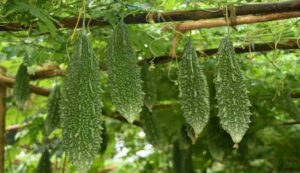Adopt these measures in bitter gourd cultivation, farmers will become rich
Bitter Gourd Cultivation: Instead of growing conventional crops, Indian farmers are making a lot of money by growing veggies. To make more money in less time, farmers choose to grow vegetables, and they are also good at it. The bitter gourd is one of them, and it’s constantly in demand. It has extremely excellent amounts of vitamins A, B, and C. Numerous elements, including iron, manganese, beta carotene, potassium, magnesium, lutein, zinc, and carotene, are found in bitter gourds and may help prevent a number of illnesses. Because bitter gourd has many medical qualities, eating it is said to be quite healthy. Farmers may make a lot of money growing bitter gourd because of its excellent market price.

Ideal soil for growing bitter gourds
The best soil type for growing bitter gourd is said to be sandy loam. In addition, alluvial soil on riverbanks is said to be suitable for growing bitter gourds.
The ideal temperature for growing bitter gourds
Bitter gourds may be grown without high temperatures. Temperatures between 20 and 40 degrees Celsius are thought to be ideal for crop production. In addition, it is crucial to keep bitter gourd fields completely wet.
More sophisticated bitter gourd variations
India has a wide variety of sophisticated bitter gourds, which farmers choose according to their region. Pusa Vishesh, Hisar Selection, Kalyanpur Barahsima, Coimbatore Long, Pusa Do Mausami, Punjab Karela-1, Punjab-14, Solan Hara, Arka Harit, Pusa Hybrid-2, Pusa Aushadhi, Solan Safed, Priya Co-1, SDU-1, Kalyanpur Sona, and Pusa Shankar-1 are some of the more well-known improved bitter gourd varieties.
The ideal season to grow bitter gourds
With the development of hybrid variants, scientists have made it possible for farmers to grow bitter gourd all year round. Bitter gourds may be planted in plain regions from June to July during the rainy season, in hilly regions from March to June, and in plain regions from January to March during the summer.
The proper method for planting bitter gourd
- Farmers should thoroughly plow the land before planting bitter gourd.
- The seeds should be soaked in water for a day before planting.
- A patta should now be used to level its field.
- Its fields should have beds made at a depth of two to three feet.
- At a distance of around one to one and a half meters, its seeds should now be sown in these beds.
- Bitter gourd seeds should be sown in the ground between 2 and 2.5 cm deep.
- The male parent should now be seeded in one-fifth of the field, and the female parent should be planted in the remaining four-fifths. The sowing should be done in separate parts.
- Farmers should maintain a 2-meter gap between the drains while planting their saplings.
- At the same time, there should be around 50 cm between each plant.
- In addition, farmers should maintain the drain’s ridges at a height of around 50 cm.
Fields with bitter gourds irrigated
The bitter gourd crop needs less watering, but field moisture retention is crucial. Farmers may use modest irrigation to keep this moisture level stable. In addition, the crop should get mild watering as blooms and fruits begin to develop. However, farmers must ensure that there is no water stagnation in their land while irrigating. In bitter gourd farms, managing drainage is crucial since failure to do so may result in crop spoilage.
Bitter gourd crop weeding
Weeding should be done by farmers at the start of the bitter gourd crop. There are a lot of unneeded other plants that grow beside it; therefore, you should weed the field and get rid of the other plants. A healthy crop of bitter gourd is produced if the plant is maintained free of weeds from the start.
The bitter gourd harvest
About 60 to 70 days after bitter gourd is sown, its harvest is ready. Only when the fruits are little and tender should farmers harvest them. Keep in mind that the bitter gourd’s stem should be up to 2 cm long while plucking; this will prolong the fruit’s freshness. It’s best to pluck it first thing in the morning.
Profit and expenses associated with growing bitter gourds
The farmer spends about Rs 30,000 per acre growing bitter gourds. Approximately 50 to 60 quintals of bitter gourd crop may be produced on one acre of land. When grown on one acre of land, farmers may make between two and three lakh rupees.





